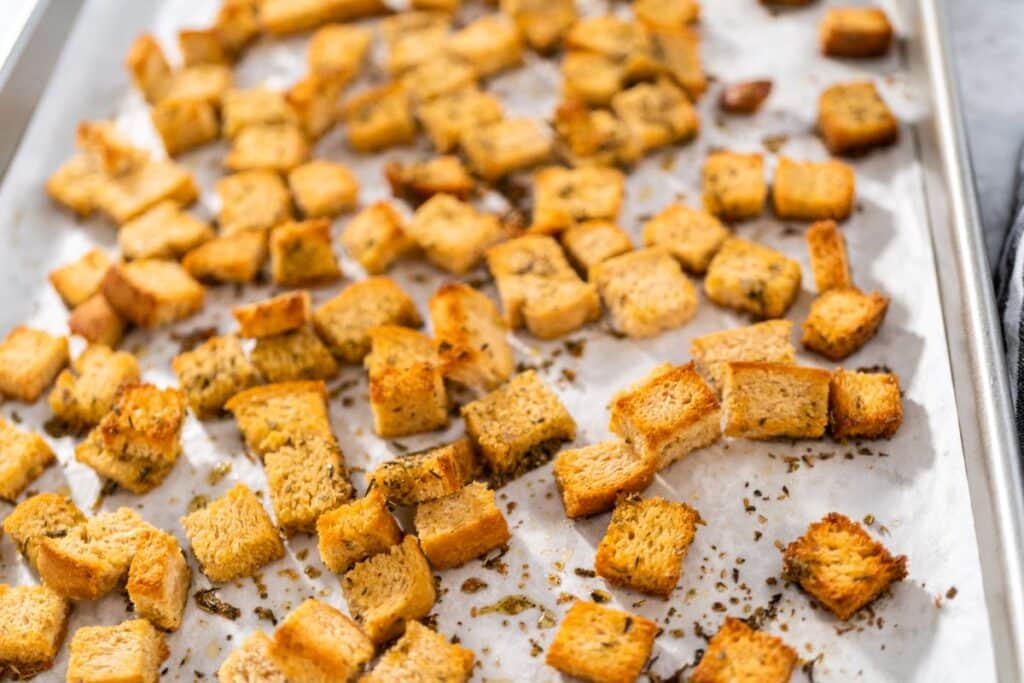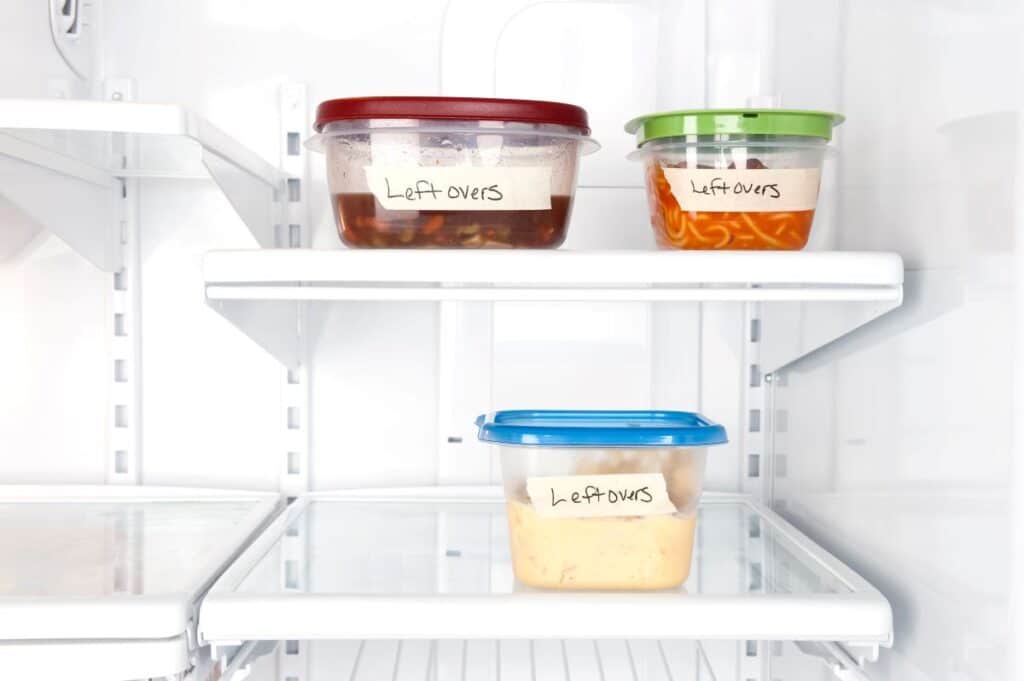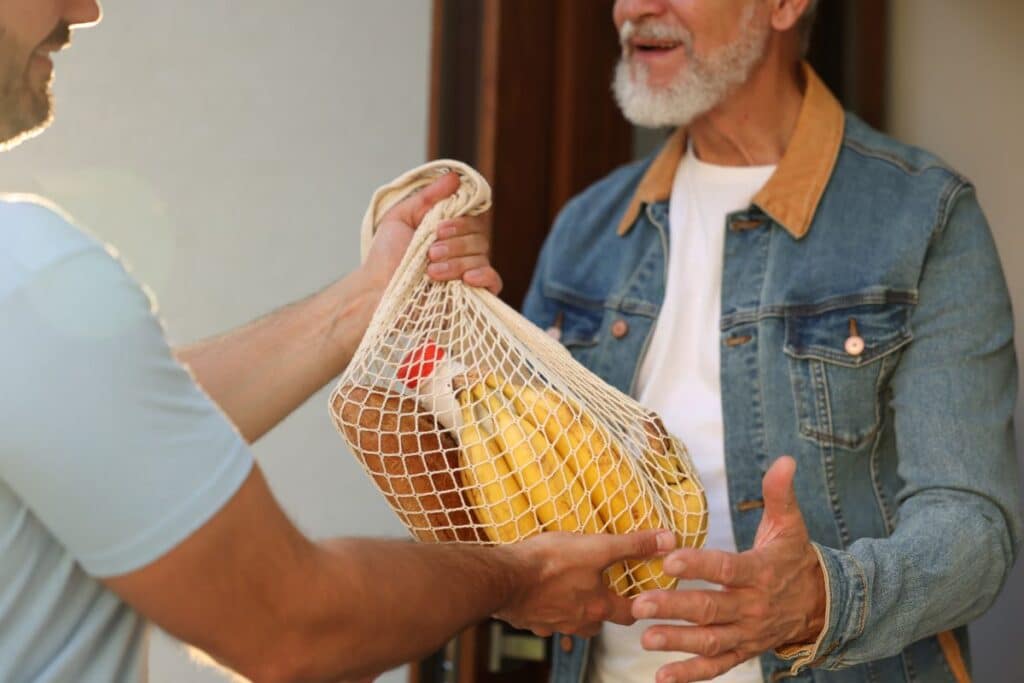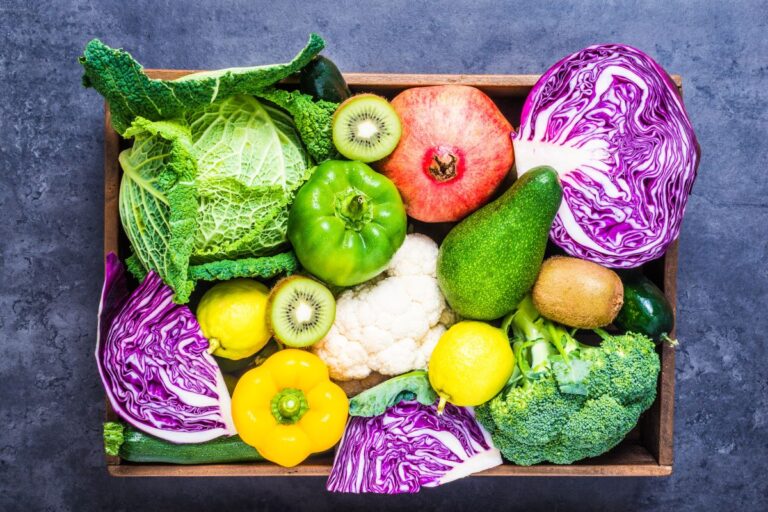How to Reduce Food Waste – 30 Practical Tips to Reduce Waste and Save Money
This website may earn commissions from purchases made through links in this post.
Households waste on average $2000 worth of food each year. Reduce food waste, save money, and save the environment with these 30 tips.

Australians throw away an estimated 2.5 million tonnes of food a year.
This costs households around $2,000-$2,500 a year and adds up to a total economic loss to the Australian economy of $36.6 billion (households contribute to around half of this economic loss) [source].
That’s a lot of waste in anyone’s books. And when it comes to the household budget, there are many things we would rather do with two grand than throw it in the bin.
It’s probably impossible to entirely eliminate food waste. I’m strict about food waste, but I still throw things away, like the two bananas that got lost under a pile of ‘stuff’ during the school holidays.
But we can do plenty of things to minimise food waste as much as possible. In this article, I share 30 tips that help us keep waste low, lowering our grocery bill.
Meal Planning and Shopping

Reducing food waste starts with planning.
1. Plan Your Meals: Meal planning reduces waste in two ways. First, meal planning means you (almost) only buy what you need. ‘Buy what you need and eat what you buy’ is my meal planning motto. I say almost because you might only need a small amount of sour cream in a planned dish, for example. You can plan a second meal or some baking to use up the rest of the sour cream.
2. Make a Shopping List and stick to it: A meal plan is super-powered when you write a shopping list at the same time. This ensures you have everything on hand to make your planned dish and reduces impulse buys, often leading to waste. These days, I do my grocery shopping online and add ingredients directly into my cart as I meal plan, saving an absolute tonne of time.
3. Buy in Bulk Wisely: Bulk buying can save you money as long as it all gets used. When buying in bulk, freeze cold perishables in portions and store pantry items in sealed containers.
4. Check Use-by Dates: Check use-by dates before buying, and choose products with longer shelf life to maximise the time you have to use them. Also, check the use-by dates of what you already have in the kitchen and plan meals around what needs to be used up.
5. Involve children in planning: avoiding waste is hard with kids. The other day, I was talking to another mum about pizza preferences, and she said she eats whatever’s left over after the kids, and I think many parents can relate to that. But one thing that does help is involving children in the planning process. It’s no silver bullet, but when they have a vested interest in a meal, they are more likely to eat it.
Save Money on the Groceries eBook

For more ways to meal plan and save money on groceries, check out the eBook Plan Cook Save: How to Eat Well When Money is Tight and Time is Short.
*Learn how to set the right grocery budget for your circumstances.
*Find out the easiest and quickest way to reduce the grocery bill.
*Discover a meal planning strategy that will only take you a couple of minutes a week but will save you hours.
Storage and Organisation

Coming from someone who has lost a lot of food to a pantry moth infestation, proper pantry storage is sooo important. Here are my tips.
6. Use Airtight Containers: Store leftovers and open packages in airtight containers to extend their freshness. Airtight containers also stop the spread of pantry moths if you get an infestation. You can help prevent pantry moths by freezing dry goods like pasta or flour for a few days to kill the moth eggs.
7. Label and Date: We buy ham in bulk and portion it into containers for school lunches. This means we often have the conversation, ‘Who defrosted the ham? How long has it been in the fridge? Labelling containers with the storage date and sometimes the use-by date (whether pantry containers, stuff in the fridge or freezer) will help to keep track of freshness. I often cut off the original label with the date and put it in the container.
8. First In, First Out (FIFO): We do this in our school tuckshop all the time – pull older stock forward and place the newer stock at the back. It doesn’t always translate to home life, though. Rotating food and using older ingredients and leftovers before newer ones to prevent food waste.
9. Good Fridge Storage: Store perishables like dairy and meat in the coldest part of the fridge, with meat at the bottom to prevent cross-contamination. Depending on your climate, there may be other things you want to keep in the refrigerator. In summer in the tropics, we keep almost everything in the fridge, including bread and potatoes, to prevent mould and rot.
Further reading: Printable Vegetable and Herb Storage Guide
10. Freeze Excess: Freeze surplus fruits, vegetables, and meats for later use. If you buy in bulk to save money, freeze foods in portions.
Portion Control

Gone are the days (I hope) when you’re forced to eat everything on your plate or else. By having smaller portions, you can eat everything without feeling stuffed.
11. Serve Smaller Portions: Start with smaller portions and allow seconds to reduce plate waste. This is especially true for young kids. Toddlers and preschoolers often need less food than we think. If you start with really small portions, there’s less waste. And they can always have seconds if they are still hungry. Uneaten seconds are easier to use as leftovers compared to plate waste.
12. Allow People to Serve Themselves: We put dinner on the table, and everyone serves themselves (normal in some cultures, less common in Australia). The only rule is that the kids have to have some veg or salad.
Cooking and Food Prep

While waste reduction starts with planning, all the art happens in the kitchen. Learning new recipes and having a few master recipes and cooking techniques under your belt means you can always cook a meal no matter what you have on hand.
13. Know a Few Master Recipes: A few master cooking methods and recipes allow you to create meals with what you have on hand rather than following a set recipe.
14. Embrace Imperfections: As long as food isn’t bad, it doesn’t have to be perfect to be good. Imperfect produce can be used as normal or hidden in soups, stews, or smoothies.
15. Use All Parts: Stock is a staple in the kitchen. You can make your own practically free by using meat bones and vegetable peelings. You can also make stock in the slow cooker, so it’s easy to do, even when busy.
16. Batch Cooking: Prepare larger batches of food and freeze portions for future meals. This reduces waste by portioning large amounts of food, and it saves time and hassle. Anything that saves time and hassle while saving money and reducing waste has to be the best tip ever!
Further Reading: 7 Master Recipes for Using Up Leftovers.
Preservation

If you can your own food, then you’re already ahead of the curve in reducing food waste.
But if you’re like me and don’t have much time, there are some easy and practical everyday ways to preserve food.
17. Flash freezing: Flash freezing involves freezing vegetables or fruit on a tray before transferring them to a bag. You can flash-freeze fruit and vegetables, but we also flash-freeze foods like homemade chicken nuggets, homemade gyoza, rissoles, sausage rolls, and chicken schnitzels.
18. Making Jam and Pickles: Small-batch refrigerator Jam is easy to make, and because you’re storing it in the fridge, you don’t need to worry about sterilising or processing jars. I’ve even made jam in the rice cooker – super easy!
19. Fermenting: Fermented vegetables like sauerkraut or kimchi not only extend the life of vegetables but are good for you too. Sauerkraut and kimchi are easy to make as well.
20 Drying: Dehydrating meats, fruit, and herbs make them last longer. If you already have a dehydrator, then drying food to prevent waste can save money. If you’re considering purchasing one, consider whether you’ll get a lot of use out of it. Other waste-reduction ideas will save more money.
Reviving Stale Food

It’s important to note that stale or limp food doesn’t mean off food. Food that is mouldy or smelly, slimy or past its use-by date isn’t safe to eat. I don’t want to encourage food poisoning. But you can revive some foods that aren’t bad but aren’t at their peak either.
21. Revive Stale Bread: You can refresh stale bread in the microwave or the oven for a few minutes. Sprinkling the bread with a tiny bit of water before putting it in the oven can make it almost as good as new. Alternatively, you can toast stale bread (great for toasties), repurpose it into croutons or breadcrumbs, or make a strata or bread and butter pudding.
22. Revive Limp Vegetables: Limp (not mouldy) vegetables like carrots, celery, and salad leaves can often be revived with water. Check out our previous article for details on reviving limp veg.
Leftover Ideas

Using up leftovers is a big part of keeping food waste minimal. I LOVE leftovers. Give me leftover stir fry over a soggy sandwich for lunch any day. And if we can eat leftovers instead of me having to cook an entire meal from scratch – favourite meals ever!
23. Save Leftovers: Pack leftovers for future lunches or dinners. Eat refrigerated leftovers within three days.
24. Repurpose Leftovers: Repurposing leftovers involves taking cooked leftovers and making a new dish. Leftover meat can be turned into pasta sauce or a pie. Roast vegetables can make tomorrow night’s pizza. Leftover spag bol can become a sloppy joe. If you’re looking for inspiration, the Netflix show, ‘Best Leftovers Ever’ is entirely dedicated to creatively repurposing leftovers.
25. Freeze Leftovers: Many leftovers, both cooked and raw, can be frozen for later. One of my favourite meals is a ‘potluck’ leftovers day when we defrost the leftover bits and bobs in the freezer to share.
26. Food Tracking Apps: There’s an app for everything, including tracking what you have in your pantry and its expiration date.
27. Recipe Apps: There are also apps and websites that can generate recipe suggestions based on what ingredients you have on hand. Let AI help you meal plan!

Leftover vegetables make a great breakfast hash. Enjoy an egg on leftover vegetables instead of toast, and you’ve got a head start on your five servings of veg for the day.
Compost Your Scraps

Food waste doesn’t mean just edible food – food scraps end up as waste, too. Composting reduces food waste to almost nothing.
28. Start Composting: Compost food scraps and non-edible kitchen waste. A bokashi bin can even compost scraps like bread and rice. For more information, check out these articles on composting:

Some councils collect food scraps for composting. This is a great option for people who live in apartments and don’t have the space to compost. If your council doesn’t provide this service, why not ask?!
Community Sharing

29. Share with your neighbours: When mum makes a cake, it’s too much for one person, so she always cuts it up and takes some to friends. That way, she can have her cake without the waste. Sharing with neighbours or swapping food can be a great way for everyone to save money and reduce waste.
30. Donate Excess: If you find yourself with more food, particularly non-perishables, than you can reasonably consume, you can donate it to charities as long as it is still in date.
Reducing food waste doesn’t just save you money; it’s good for the environment – a double win! With these 30 food waste tips, we can minimise food waste and save.








It’s sad to think how much we waste. I’ve tried to plan meals ahead but found it difficult not to end up with tonnes of left over ingredients that end up in the bin… :(
This is so true, and it’s sad to think about all that is wasted. If we are mindful of how much we are purchasing, we can save a lot more money and resources. Great post!
Thanks for your comments. You are very right, it’s about being mindful.